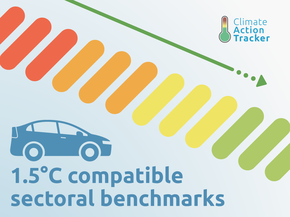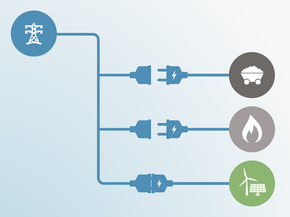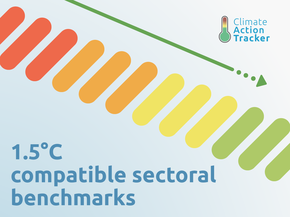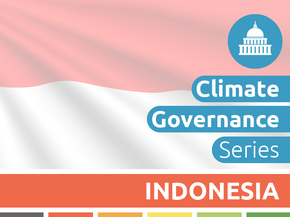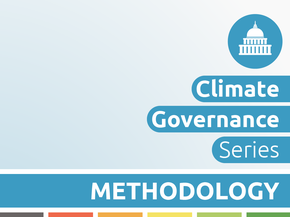Country summary
Overview
After a year in office, Indonesia's Prabowo-Gibran administration has pushed for self-sufficiency in food and energy alongside an ambitious 8% economic growth target, often at the expense of environmental integrity. While headline commitments such as net zero by 2060 remain in place, recent developments indicate weakening domestic ambition. Overall, Indonesia's progress in transitioning to a low-carbon economy remains limited, with little meaningful change across critical sectors. Power generation and industry remain heavily reliant on coal, while land use emissions persist due to agricultural and commodity-driven deforestation.
Indonesia’s 2035 climate pledge (NDC) improves transparency but fails to raise real ambition. Under its unconditional target, emissions are set to keep rising for decades, peaking only around 2050 at more than twice today’s levels. The target is overachieved with currently implemented policies. Even the conditional target depends on steep emissions reductions after 2035 to reach net zero by 2060 – these reductions are unlikely to occur without credible policies, proper implementation and international support. Indonesia's overall rating remains "Critically insufficient".
In October 2025, ahead of COP30, Indonesia submitted its 2035 NDC to the UNFCCC. This new submission marks a positive shift in terms of transparency, shifting from a 2010 Business-as-Usual (BAU) baseline to a historical reference year (2019). However, Indonesia has not formally strengthened its 2030 target, and its 2035 unconditional targets remain far above a 1.5°C compatible fair share pathway. In the unconditional scenario, emissions are set to keep rising for the next 25 years, peaking in 2050 at more than double 2019 levels (excl. LULUCF). The conditional targets offer marginally stronger emission reductions but rely heavily on steep emissions cuts after 2035 to reach net zero by 2060. A full analysis is available on our 2035 NDC page.
Despite its vast untapped renewable energy potential, the nation’s power sector remains dominated by coal and gas, with slow progress on renewable deployment. The latest National Electricity Supply Business Plan (RUPTL) 2025-2034 sets more ambitious targets for renewables and storage, but delays over 70% of the planned 42.6 GW renewable capacity additions until after 2030.
In contrast, the plan frontloads fossil fuel expansion, adding 12.7 GW of new fossil capacity by 2029. This trajectory risks locking in emissions, deepening the country's long-term fossil dependency, and potentially exacerbating oversupply, particularly given the Prabowo administration’s assumption of 8% annual GDP growth, which is well above historical trends and could crowd out renewables from an already saturated grid. The new RUPTL also proposes integrating nuclear power by 2033, despite Indonesia’s location on the seismically active Pacific “Ring of Fire”, which raises serious safety concerns.
While Presidential Regulation No. 112/2022 provides a legal basis for an early coal retirement roadmap, implementation remains uncertain. The official list of coal-fired power plants eligible for early retirement has yet to be issued, and the plan is largely contingent on securing international financing. Recent developments indicate that the planned early retirement of PLTU Cirebon-1 (660 MW) is unlikely to proceed. Overall, Indonesia’s power sector is not on track to be aligned with a 1.5°C pathway, with the share of renewables in the power generation mix stagnating at around 14% Based on CAT’s Paris-aligned benchmarks for the power sector, Indonesia must generate at least 55%, and ideally up to 82%, of its electricity from renewables by 2030. Compounding these issues is the long-awaited New and Renewable Energy Bill, which remains delayed due to disagreement over power wheeling provisions.
The National Electricity Master Plan (RUKN) 2024-2060 further enables over 20 GW of captive coal capacity to power nickel and mineral processing industries, which could increase captive coal capacity by 180% over the next seven years. The forthcoming revision of the JETP Comprehensive Investment and Policy Plan (CIPP) aims to include captive power and improve focus on efficiency and electrification, structural challenges continue to hinder progress. Even if fully implemented, the scheme alone would fall short of placing Indonesia on a 1.5°C-aligned pathway. Despite Indonesia’s clear need for international support, as also highlighted in their new 2035 NDC, financing under international partnerships such as JETP remains dominated by loans.
Indonesia’s mitigation strategy continues to rely heavily on the land sector, particularly through the Forestry and Other Land Use (FOLU) Net Sink 2030 target, which pledges net negative emissions of 140 MtCO₂e by the end of the decade. However, the credibility of this target has been called into question due to conflicting development priorities, such as food estate expansion and large-scale bioenergy projects. While the pursuit of food and energy security is legitimate, the current approach risks accelerating deforestation and jeopardising the feasibility of reaching net sink status. Alternative development strategies, such as electrifying transport demand rather than relying on high biofuel blending targets, could deliver energy security without driving large-scale forest loss.
Indonesia's current policies lead to a strong increase in future emissions and do not yet put it on a low-carbon trajectory. Key measures needed for strengthening Indonesia’s climate action are:
- Create an enabling environment for the energy transition: expedite the passage of the New and Renewable Energy Bill and establish a clearer regulatory framework that lowers barriers to renewables deployment. This includes implementing stronger carbon pricing mechanisms, amending regulations favouring coal, and reforming demand-side fossil fuel subsidies in a just and equitable manner.
- Strengthen forest protection and governance: upgrade the moratorium on primary forest and peatland conversion into a legally binding law or presidential regulation and extend it to concession areas and secondary forests. To uphold its FOLU Net Sink 2030 target, the government should strengthen enforcement, particularly in light of rising deforestation risks from palm oil expansion and expanding biofuel mandates.
- Align energy transition with environmental and social safeguards: strengthen the mandatory environmental and social impact assessments and ensure they are properly enforced across all large-scale development programmes, particularly the food estate initiative and development of downstream industries. The government should reassess projects that exacerbate deforestation, biodiversity loss, and the displacement of local communities. The pursuit of food and energy security does not need to come at the expense of environmental integrity.
Despite the uncertain outlook and mixed progress in the development of policies and targets, there have been several positive developments worth highlighting:
- New regulations (MEMR Regulation 10/2025 and 5/2025) have been introduced to create a clearer energy transition roadmap, while providing greater investment certainty for renewable energy projects by improving the terms of power purchase agreements.
- The upcoming JETP CIPP update includes strategies to decarbonise captive coal power along with new focus areas such as energy efficiency and electrification, carbon pricing instruments, and mainstreaming just transition. While the US has withdrawn its funding, Germany and Japan have taken over as JETP co-leads. Attention is gradually shifting to improving project viability and expanding captive renewable generation.
- The inclusion of the Climate Change Bill in the 2025 Priority National Legislation Program signals the new administration’s intent to establish a legal foundation for climate governance. If passed, it would provide legal certainty for climate policy and finance, though its effectiveness will depend on political will, enforcement capacity, and meaningful stakeholder participation.
See our Policies and action section for more information.
Description of CAT ratings
The CAT rates each country’s targets and policies against (1) its fair share contribution to climate change mitigation considering a range of equity principles including responsibility, capability and equality, and (2) what is technically and economically feasible using modelled domestic pathways which, in absence of a better method, are based on global least-cost climate change mitigation.
Comparing a country’s fair share ranges and modelled domestic pathways provides insights into which governments should provide climate finance and which should receive it. Developed countries with large responsibility for historical emissions and high per-capita emissions, must not only implement ambitious climate action domestically but must also support climate action in developing countries with lower historical responsibility, capability, and lower per-capita emissions.
The CAT rates Indonesia’s climate targets and policies “Critically Insufficient”. which indicates that Indonesia’s climate policies and commitments reflect minimal action and are not at all consistent with the Paris Agreement’s 1.5°C temperature limit. Under Indonesia’s targets and policies, emissions will continue to rise and are consistent with more than 4°C warming.
Indonesia is far from meeting its fair share contribution to climate change mitigation. Indonesia’s unconditional NDC and policies and actions are rated as “Highly insufficient” when compared to its fair share. Indonesia’s conditional NDC is rated as “Critically Insufficient” when compared to modelled domestic pathways. As a country with lower responsibility, capability, and per-capita emissions, Indonesia should receive international support to set an ambitious conditional NDC target beyond its national fair share and implement the policies necessary to achieve it.
To get a better rating, Indonesia must adopt stronger climate targets that do not overly rely on the LULUCF sector as a net sink and introduce policies capable of peaking emissions by 2030, curbing emissions growth, and placing the country’s emissions on a sustained downward trajectory.
The CAT rates Indonesia’s policies and actions “Critically Insufficient” when compared to their fair share contribution to climate change mitigation.
The “Highly Insufficient” rating indicates that Indonesia’s climate policies and action are not consistent with the Paris Agreement’s 1.5°C temperature limit and lead to rising, rather than falling, emissions. If all countries were to follow Indonesia’s approach, warming could reach over 3°C and up to 4°C.
In our 2023 assessment, we rated current policy projections “Critically Insufficient”, driven by a sharp increase following the quantification of emissions from Indonesia’s off-grid coal power pipeline. While this figure remains unchanged, the rating improves slightly in this update due to revisions to our fair share ranges and equity literature.
The power sector remains dominated by fossil fuels. The RUPTL 2025–2034 backloads most renewable additions until after 2030 while expanding coal and gas capacity in the near term. Industrial policy reinforces this trajectory. The industrial “downstreaming” agenda, which refers to the country’s strategy to extract more natural resources, reduce raw material exports, and process them domestically into higher-value goods, has accelerated emissions-intensive production in nickel and mineral processing industries, with captive coal capacity for industry set to expand sharply over the next decade.
While the JETP enhances ambition beyond national plans, it still falls short of a Paris-compatible decarbonisation pathway. To be 1.5°C aligned, Indonesia needs to generate at least 55%, and ideally up to 82%, of its power from renewables by 2030, which will require significant international support.
The forestry sector, historically contributing nearly half of national emissions, remains central to Indonesia’s net zero strategy through the FOLU Net Sink 2030 target. However, the credibility of this target is now being questioned amid calls for a “more realistic” approach that accommodates bioenergy and agricultural expansion. In parallel, food-estate projects continue to drive land-use change in forest and peat areas, with little evidence of improved food security outcomes.
The full policies and action analysis can be found here.
We rate Indonesia’s conditional NDC target as “Critically insufficient” when compared to modelled domestic pathways. The “Critically insufficient” rating indicates that Indonesia’s internationally supported target in 2030 reflect minimal to no action and are not at all consistent with modelled domestic pathways limiting warming to 1.5°C temperature. If all countries were to follow Indonesia’s approach, warming would exceed 4°C.
This rating takes into account that Indonesia would need international support to be consistent with the 1.5 °C temperature limit.
We rate Indonesia’s unconditional target as “Highly Insufficient” when compared to its fair share emissions allocation. This rating indicates that Indonesia’s fair share target in 2030 is not consistent with the Paris Agreement’s 1.5°C temperature limit and lead to rising, rather than falling, emissions. If all countries were to follow Indonesia’s approach, warming could reach over 3°C and up to 4°C.
In our 2024 assessment, we rated the unconditional NDC target against fair share “Critically Insufficient”. While this figure remains unchanged, the rating improves slightly in this update due to revisions to our fair share ranges and equity literature.
Indonesia’s emissions from land use, land use change and forestry (LULUCF) sector, on average, have accounted for almost half of the country’s total emissions over the last 20 years.
The forestry sector, through the Forestry and Other Land Use (FOLU) Net Sink 2030 target, which aims for net negative emissions of 140 MtCO₂e, serves as the backbone of Indonesia’s mitigation efforts. This target is increasingly challenged by conflicting national development priorities, including bioenergy expansion and food estate projects, which continue to drive deforestation and peatland conversion.
The CAT does not yet evaluate Indonesia’s net zero target given the lack of more detailed information.
Indonesia is exploring scenarios that could lead to net zero by 2060 or sooner in its Long-Term Strategy for Low Carbon and Climate Resilience (LTS-LCCR) document submitted to the UNFCCC in July 2021. A net zero pathway is also included in the upcoming 2035 NDC, particularly under the Low Carbon Scenarios Compatible with the Paris Agreement (LCCP), which may be interpreted as the country’s conditional targets under both low and high economic growth scenarios.
As a developing economy, Indonesia’s goal of reaching net zero for all greenhouse gases by 2060 can be considered ambitious and broadly aligned with what is needed globally to limit warming to 1.5°C, as outlined in the IPCC’s Sixth Assessment Report (AR6). However, the target relies on steep emissions reductions after 2035, with minimal or no reductions before then and only a plateau around 2030. This delayed trajectory is why Indonesia’s near-term NDC targets are rated as “Highly Insufficient” or “Critically Insufficient”, even as the long-term net zero target is viewed as more ambitious.
Further analysis
Country-related publications
Stay informed
Subscribe to our newsletter

